By Chris Lango
The city of Sacramento has acquired so many slogans, nicknames and monikers through the years it’s tough to keep track: Gateway to the Gold Rush, City of the Plains, City of Trees, the Big Tomato, River City, America’s Most Diverse City, Capital of the 6th Largest Economy in the World, America’s Farm-to-Fork Capital, Almond Capital of the World, Camellia Capital of the World, Birthplace of the Transcontinental Railroad and Mark Twain’s favorite, City of Saloons.
But since the late 1940s, one word has defined downtown Sacramento more than just about any other: redevelopment. Virtually every area in the central city has been impacted by redevelopment. Some neighborhoods have even felt the impact of re-redevelopment.
A century after Sacramento pioneered the development of the West during the Gold Rush, the city found itself in the vanguard once again – this time during Redevelopment, when urban cores were carved up and transformed in the years following World War II. Sacramento paved the way for that transformation by pioneering a redevelopment blueprint that became a model for the nation. The city also demonstrated the devastation of redevelopment by displacing hundreds of businesses and thousands of residents from its own urban core.

The Sacramento Redevelopment Agency, created in December of 1950, became the driving force behind the massive efforts to reshape the city in the decades to come. “It had a lot of power,” longtime city historian James Henley later recalled. “At one point, the redevelopment agency had so much money flowing in from project development that it was called ‘Little City Hall.’ And it was the city hall that had the money that you could do something with.”

It’s fitting the Urban History Association selected the month of April to declare Sacramento its Metropolis of the Month because two interesting moments in the city’s urban redevelopment history took place in two different Aprils – ten years apart.
The first, on April 14, 1954, was the initial public hearing conducted by the Sacramento Redevelopment Agency, when it presented its first urban renewal plan – the Capitol Mall Project – a plan that would demolish a 15-square block area of Sacramento’s West End and replace it with a “grand gateway” into the city. The second came ten years later (nearly to the day) in April of 1964, when Sacramento won the top prize for that plan in a nationwide competition to determine the best urban renewal project in America. That win, however, would prove to be a hollow victory.
The West End of Sacramento was generally considered the area between the State Capitol and the Sacramento River. As the city’s first community and its original business district, the West End welcomed people from around the world.

It became Sacramento’s most populated, diverse, integrated, and historic neighborhood—a mixed-use, mixed-income tract where many languages were spoken. It was home to a wide variety of businesses and residents. But in the 1940s and ‘50s, city and business leaders viewed it as a negative, declaring the entire West End blighted and the riverfront a skid row.

At that first hearing in 1954, battle lines were drawn that would define redevelopment in Sacramento for the next decade. The Capitol Mall Project was widely endorsed by 14 organizations, including the Sacramento Chamber of Commerce, the Builders’ Exchange, the Association of Landscape Architects, the American Society of Civil Engineers, the Sacramento Area Planning Association and the League of Women Voters.

Standing in the way was Sacramento’s Japantown, a signature West End neighborhood dating back to the 1880s. Often called a city within a city, it became one of the most significant Japanese communities in the United States—home to some 300 businesses and 4,000 residents.

Henry Taketa, a well-known local attorney and prominent Sacramento-born Japanese-American, was the first to speak in opposition to the plan and express concern that tearing down homes and businesses and relocating residents would cause great harm to those displaced.
Two months later, when the Capitol Mall plan reached City Hall, an overflow crowd attended a special meeting of the Sacramento City Council. Again Henry Taketa, whose law practice stood on the corner of 4th Street and Capitol Avenue in the heart of Japantown, was the first to speak.

“We have our whole heart and soul in what will take place here,” he told the Council. “Our fathers and mothers came here in their youth, and now they are reaching the twilight years of their lives … We have considerable fondness for our community. For that reason, after our wartime dislocation, we always dreamt of coming back here, and when I say ‘coming back here’ I mean to Sacramento. I would say 90 percent of the people who lived here before the war have returned.”

It had been only nine years since residents of Japantown returned from internment during World War II. Now they faced the prospect of a second forced dislocation. Initially their plea was heard and their community spared. In the November elections of 1954, a 1.5 million dollar bond measure asking the public to pay for the initial costs of the Capitol Mall Project failed. Japantown and other West End neighborhoods were saved from the wrecking ball.

But within days of the Election Day defeat, the Sacramento Redevelopment Agency decided to pursue a different path and work around the electorate. The agency set out to implement a new funding mechanism approved by the California Legislature two years prior—a strategy that had never been tried and did not require a vote. It became known as Tax Increment Financing, and Sacramento was the first city to use it. The results would transform urban renewal all across America.
With an initial price tag of six million dollars to clear the land and pave the way for Capitol Mall, the agency’s then-executive director Jerome Lipp went on local television in 1959 to explain how the financing model worked: “Two-thirds of that six million will be paid for by the federal government. The balance of two million dollars—the local one-third—this agency itself pays for by issuing its own bond issue. This bond issue is secured by the increase in tax revenue that will flow from this project when the new buildings are in place … The increased amount is then deposited into a special fund to retire our bond … And then any additional revenue will flow directly into the city and the county treasury. This is why we say redevelopment more than pays for itself. I expect the Capitol Mall Project to demonstrate to this city and to other cities what can be accomplished through redevelopment.”
On May 5, 1955, the federal government approved the Sacramento Redevelopment Agency’s financing plan. On July 1, 1956, the agency issued its first tax-increment bond of $2,000,000. Six months later, on January 29, 1957, the demolition of Japantown and the West End began.

That day in 1957 was hailed as a celebration of the future of Sacramento. California governor Goodwin Knight presided over the proceedings, even operating the crane that brought down the first building—a two-story house near the corner of 6th Street and Capitol Avenue.

“Sacramento has passed the threshold of a magnificent promise for the future,” the governor said. “The factors which made our city the hub of pioneer activity during the Gold Rush make it the logical hub of a mighty economic empire in the years ahead.”
In the two years that followed, the 15 square blocks were cleared and thousands of residents were displaced. For those in Japantown, redevelopment not only meant a second forced relocation; this time it meant that their entire “city within a city” vanished.
“I was mad,” recalled former Japantown resident April Adachi. “I thought, ‘not again, we’ve got a double-dipper here.’ First, they chased us out to go to camp, then we came back – and all the businesses were doing okay …”
“There’s nothing—as you drive into Sacramento—no remnant of Japantown,” added another former resident, Marian Uchida. “Even if they put up cherry blossom trees, you could say this was a reminder of Japantown. But we don’t have that.”
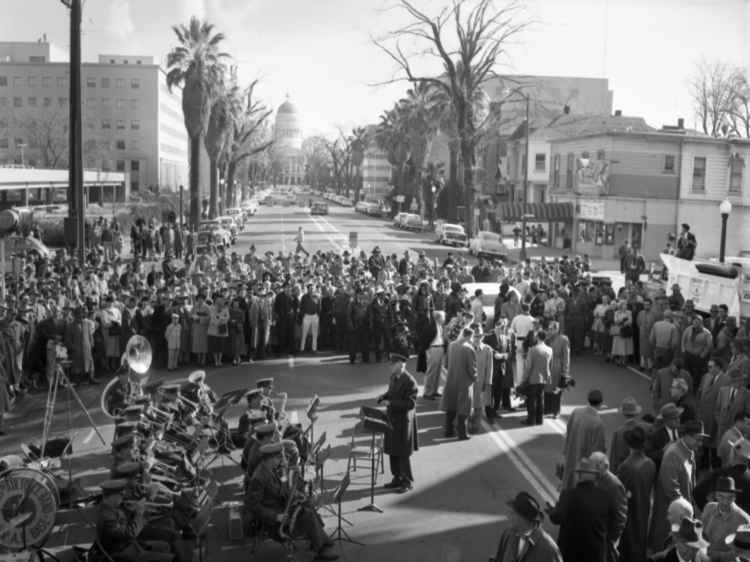
Sacramento author and historian William Burg described the demolition as “a very thorough destruction of a Japantown, probably the most thorough on the west coast. And considering that Sacramento was, by population percentage in the 1920s, the most Japanese of any American city, it’s really a significant change.”
In addition to the Japanese community, other minority groups in the West End were moved out as well. But because of redlining and racially restrictive covenants existing in Sacramento’s newer neighborhoods, their housing options were limited.

Nathaniel Colley, Sacramento’s first African-American attorney, represented many West End residents during this period of redevelopment.
“There are certain human values at stake here that we are not paying enough attention to,” Colley argued during a speech at Sacramento State University in 1960. “Usually, minority group people are the ones who inhabit the areas first cleared by urban redevelopment. But it seems to me almost immoral for a government to go in and tell a slum dweller we’re going to clear you out—and then have him go out and face a closed housing market.”
One African-American woman who was relocated to Oak Park in the early 1960s recalled her experience years later: “I’m part of the influx of Blacks from the West End when the West End was redeveloped. When people were being replaced … and they started designating where people were going to go in order to have them get out of the way, they designated Blacks to Oak Park… This is what I call the beginning of the destruction of Oak Park.”
Thus began the cycle of redevelopment in one of Sacramento’s outer communities—a cycle that continues today. Oak Park soon become tagged as “blighted” and a “slum,” and years later it too would become a redevelopment zone.
Also lost from Capitol Avenue were businesses and institutions that made the West End such an interesting place for so many people. Two of Sacramento’s most famous jazz clubs were located across the street from each other right at that same intersection of 6th and Capitol.

The MoMo and the Zanzibar clubs attracted such iconic artists as Billie Holiday, Count Basie, Duke Ellington and Louis Armstrong, who would often perform after-hours shows at these clubs following their concert performances at larger venues like the Memorial Auditorium.
They also attracted an integrated clientele—a rarity in Sacramento during the 1940s and 50s.

“(These clubs) served a very good purpose in terms of introducing people to one another,” recalled Clarence Caesar, a retired historian for the state of California. “And it paid off in later years because as the civil rights movement became more prominent, people became more interested in integration. So the Momo and Zanizibar … created the basis for people to come together.”

“That’s jazz’s unique power,” added William Burg. “Decades before the civil rights movement, it’s encouraging this cross-cultural connection that translates into subsequent generations of music. And they become American ideals with cross-racial, cross-cultural appeal. And Sacramento was a fantastic example of how that process happened. It’s just that the evidence has been mostly wiped away by redevelopment.”
On July 27, 1959, ground was broken on the Capitol Mall’s first construction project: the new federal building at 6th Street and Capitol Avenue. And this time, a new governor, Pat Brown, led the celebration.
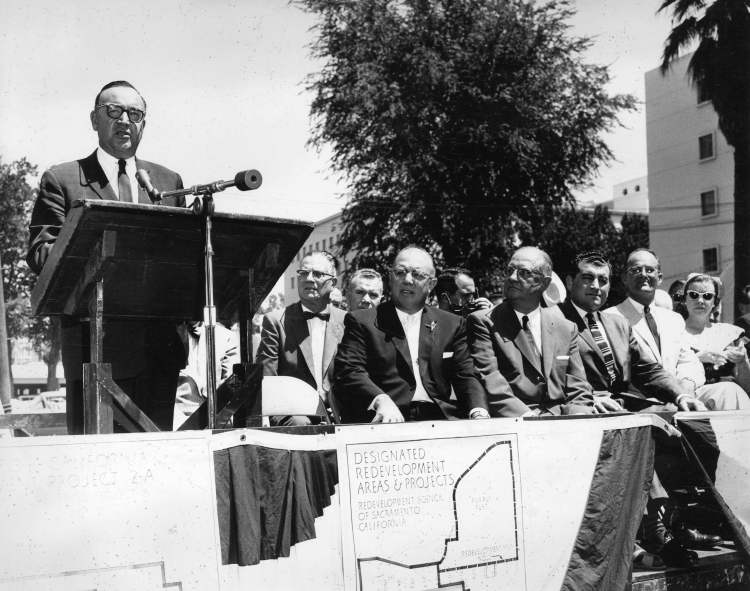
“This is a magnificent moment,” Gov. Brown said. “Here on this spot beauty will replace blight. All this is due to the enterprise of the people of Sacramento. The success you have will be seen all over the United States….”
The 6.5 million dollar federal building was also the first urban renewal construction project in the western U.S. And it immediately demonstrated the upside of the Sacramento redevelopment model, generating 70 percent of the tax revenue formerly collected by the entire 15 blocks of the Capitol Mall redevelopment zone.
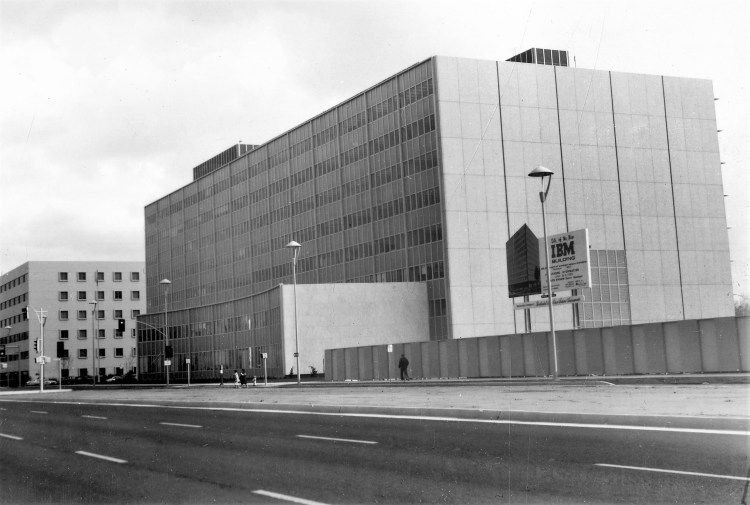
In the end, the transformation of Capitol Avenue into Capitol Mall earned Sacramento high praise from across the country. On April 7, 1964, nearly 10 years to the day after the first public hearing on the Capitol Mall Project, Sacramento bested 24 cities from around the country to win the 1963 Ward Melville Gold Medal, a prestigious community development award presented annually by a New York-based financier and philanthropist to the city judged to have the best urban renewal project in the country.
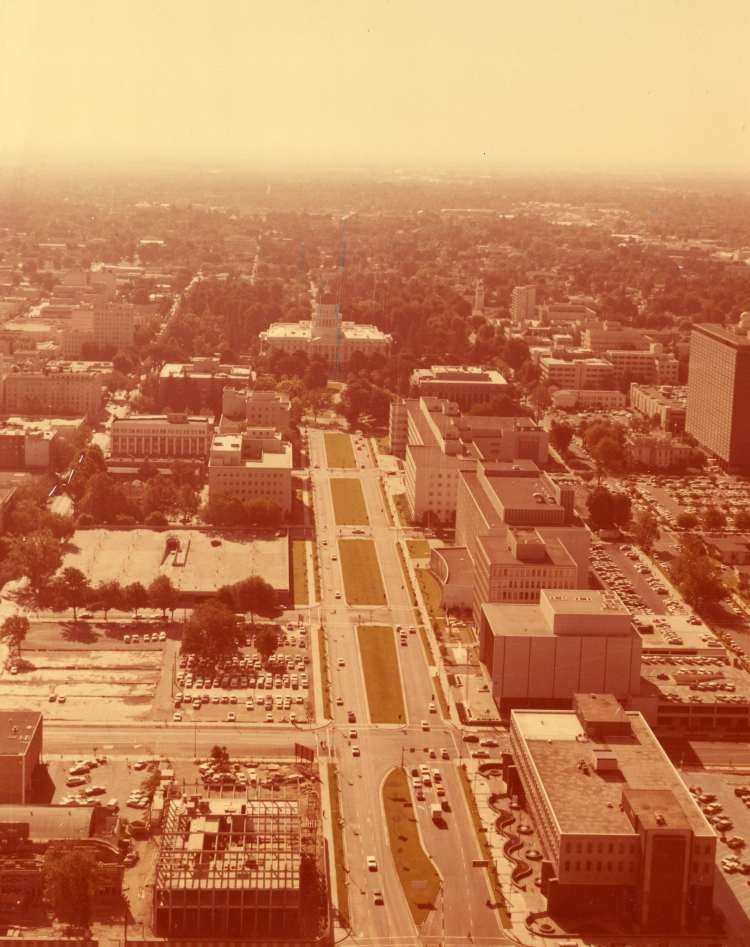
In accepting the award, Sacramento mayor James B. McKinney said, “it exemplifies the vast improvements which have been made in our community—and we will continue to make improvements in the future.”
But the award would prove hollow. Indeed, property values in the redevelopment zone did skyrocket. IBM, Crocker Bank, Wells Fargo, Bank of America and other companies joined the Federal Building on Capitol Mall. A new Macy’s opened just around the corner. But the sense of community that was destroyed has yet to be replaced over 60 years later.
The US Census numbers demonstrate the human void. Before redevelopment, in 1950, 4,467 people lived in the census tract that included almost all of Japantown and Capitol Mall. After redevelopment, in 1970, that number dropped to 377, a population loss of 92 percent. In the original 15-block area of the Capitol Mall Project, 350 businesses were displaced.
As the wheels of redevelopment continued to roll, the skid row area along the riverfront was redeveloped into Old Sacramento—the first urban historic district in the nation to be financed with urban renewal and tax-increment funds. The area immediately to the east of Old Sac became Interstate 5. The stretch of K Street on the other side of the freeway became the Downtown Plaza, an enclosed and open-air two-story shopping center. It since has been demolished and redeveloped into Downtown Commons, featuring the Golden 1 Center arena and the new Sawyer Hotel. Further east, K Street, Sacramento’s original Main Street, was redeveloped into a pedestrian mall in 1969. Nearly 50 years, later it was returned to a street.
Back on Capitol Mall, the entire square block between 3rd and 4th Streets—once the heart of Japantown and the home to Henry Taketa’s law office—was redeveloped into the headquarters of the Sacramento Union newspaper in 1968. Twenty-five years later, the Union folded. The building itself hung on for another decade or so, and in 2005 it too was demolished to make way for a pair of 53-story towers featuring luxury condominiums and a hotel. The towers were never built, and for the past 13 years this entire square block at a seminal location near the gateway to the city is still a fenced-off hole in the ground.
And so as Sacramento continues to redevelop itself and repopulate its downtown, will it become a pioneer again? The answer is still to be determined. The city’s housing crisis is perhaps the most important and most challenging problem to be solved. Like many cities, Sacramento now desires a creative, diverse and integrated mix of businesses and residences. It desires a mixed-use, mixed-income, densely populated urban core featuring many of same qualities that were moved out a half a century earlier.
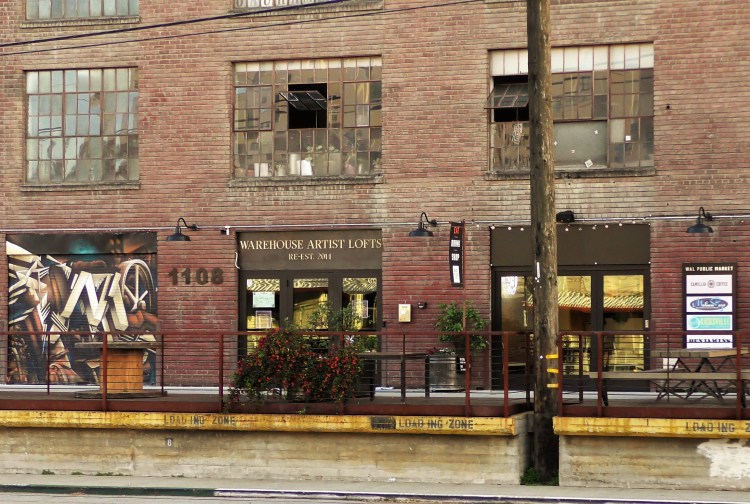
 Chris Lango’s career a producer writer and narrator has spanned 30 years. Most of that time was spent as a sports producer for stations in his hometown of Detroit – followed by a stop in Hartford, CT before joining KCRA in Sacramento in 1993. For the next 15 years, Chris produced the station’s sportscasts as well as special series and feature programs. Since 2010, Chris has done volunteer work and video production at the Center for Sacramento History. He and videographer Steve Davis have created two documentary television programs for the Center. The first, “The Time is Now“, profiles Sacramento’s first African-American attorney Nathaniel Colley; the second, “Replacing the Past“, shines a light on the gains and losses during the redevelopment of downtown Sacramento in the 1950s and 60s. Both of those programs have aired on KVIE, the local PBS affiliate in Sacramento.
Chris Lango’s career a producer writer and narrator has spanned 30 years. Most of that time was spent as a sports producer for stations in his hometown of Detroit – followed by a stop in Hartford, CT before joining KCRA in Sacramento in 1993. For the next 15 years, Chris produced the station’s sportscasts as well as special series and feature programs. Since 2010, Chris has done volunteer work and video production at the Center for Sacramento History. He and videographer Steve Davis have created two documentary television programs for the Center. The first, “The Time is Now“, profiles Sacramento’s first African-American attorney Nathaniel Colley; the second, “Replacing the Past“, shines a light on the gains and losses during the redevelopment of downtown Sacramento in the 1950s and 60s. Both of those programs have aired on KVIE, the local PBS affiliate in Sacramento.



Excellent recap of the Sacramento neighborhood I remember as “Skid Row”. I left Sacramento in 1960 and I thank you for the reminder of memories long forgotten.
LikeLike
I was born and reared in Sacramento, and have lived at many different places since then. Sacramento still pulls at my heart strings, and enjoy my infrequent visits there, and really enjoy Old Sacramento. Out of the four children in our family, only one is left in Sacramento. A sister lives in Elk Grove, and brother lives in Lodi, and I live in Sunnyvale. I attended a 50th anniversary Lincoln School gathering some years ago, and a strange thing happened. Everybody didn’t look familiar at all until a few hours later when their personalities and names came back. s/Tak Nomura
LikeLike
Thank you for sharing your memories of Sacramento!
LikeLike
Appreciate this history of when I was a child and didn’t realize the impact of what was going on in my Sactown.
LikeLike
I was born and raised in Sacramento,and at 41 years old,and certainly not the first time,my blood begins to boil at the sheer stupidity of this city,and the misery it has inflicted on its residents,long before i was born! . such wonderful history,lost,due to a bunch of morons with tunnel vision.
LikeLike